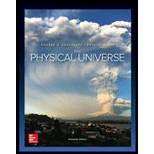
Concept explainers
At night the pupils of a certain woman’s eyes are 8 mm in diameter. (a) How many kilometers away from a car facing her will the woman be able to distinguish its headlights from each other? (b) What would the distance be if her pupils were 4 mm in diameter (say at twilight)? Assume that the headlights are 1.5 m apart, that the average
(a)
The range at which car’s head light can be distinguishable.
Answer to Problem 72E
The range at which car’s head light can be distinguishable is
Explanation of Solution
Given info:
The separation between the headlights is
Since the eyes attain only half of the resolving power, the distance will be half of the range obtain.
Write an expression to calculate the range at which car’s head light can be distinguishable.
Here,
Substitute
Thus, the range at which car’s head light can be distinguishable is
Conclusion:
The range at which car’s head light can be distinguishable is
(b)
The range at which car’s head light can be distinguishable.
Answer to Problem 72E
The range at which car’s head light can be distinguishable is
Explanation of Solution
Given info:
The separation between the headlights is
Since the eyes attain only half of the resolving power, the distance will be half of the range obtained.
Write an expression to calculate the range at which car’s head light can be distinguishable.
Here,
Substitute
Thus, the range at which car’s head light can be distinguishable is
Conclusion:
The range at which car’s head light can be distinguishable is
Want to see more full solutions like this?
Chapter 7 Solutions
Physical Universe
- Why is it much more difficult to see interference fringes for light reflected from a thick piece of glass than from a thin film? Would it be easier if monochromatic light were used?arrow_forwardFor 600-nm wavelength light and a slit separation of 0.12 mm, what are the angular positions of the first and third maxima in the double slit interference pattern?arrow_forwardIf a hologram is recorded using monochromatic light at one wavelength but its image is viewed at another wavelength, say 10% shorter, what will you see? What if it is viewed using light of exactly half the original wavelength?arrow_forward
- An effect analogous to two-slit interference can occur with sound waves, instead of light. In an open field, two speakers placed 1.30 m apart are powered by a single-function generator producing sine waves at 1200-Hz frequency. A student walks along a line 12.5 m away and parallel to the line between the speakers. She hears an alternating pattern of loud and quiet, due to constructive and destructive interference. What is (a) the wavelength of this sound and (b) the distance between the central maximum and the first maximum (loud) position along this line?arrow_forwardA source of light having two wavelengths 550 nm and 600 nm of equal intensity is incident on a slit of width 1.8 m. Find the separation of the m=1 bright spots of the two wavelengths on a screen 30.0 cm away.arrow_forwardConsider a single-slit diffraction pattern for =589 nm, projected on a screen that is 1.00 m from a slit of width 0.25 mm. How far from the center of the pattern are the centers of the first and second dark fringes?arrow_forward
- Consider a wave passing through a single slit. What happens to the width of the central maximum of its diffraction pattern as the slit is made half as wide? (a) It becomes one-fourth as wide. (b) It becomes one-half as wide. (c) Its width does not change. (d) It becomes twice as wide. (e) It becomes four times as wide.arrow_forwardA Michelson interferometer with a He-Ne laser light source (=632.8nm) projects its interference pattern on a screen. If the movable mirror is caused to move by 8.54 m , how many fringes will be observed shifting through a reference point on a screen?arrow_forwardA microwave of an unknown wavelength is incident on a single slit of width 6 cm. The angular width of the central peak is found to be 25°. Find the wavelength.arrow_forward
- How far apart must two objects be on the moon to be distinguishable by eye if only the diffraction effects of the eye’s pupil limit the resolution? Assume 550 nm for the wavelength of light, the pupil diameter 5.0 mm, and 400,000 km for the distance to the moon.arrow_forwardConsider the single-slit diffraction pattern for =600 nm, D=0.025 mm , and x=2.0 m. Find the intensity in terms of Io at =0.5 , 1.0°, 1.5°, 3.0°, and 10.0°.arrow_forwardCalculate the wavelength of light that produces its first minimum at an angle of 36.9° when falling on a single slit of width 1.00 m.arrow_forward
 University Physics Volume 3PhysicsISBN:9781938168185Author:William Moebs, Jeff SannyPublisher:OpenStax
University Physics Volume 3PhysicsISBN:9781938168185Author:William Moebs, Jeff SannyPublisher:OpenStax Physics for Scientists and Engineers: Foundations...PhysicsISBN:9781133939146Author:Katz, Debora M.Publisher:Cengage Learning
Physics for Scientists and Engineers: Foundations...PhysicsISBN:9781133939146Author:Katz, Debora M.Publisher:Cengage Learning Principles of Physics: A Calculus-Based TextPhysicsISBN:9781133104261Author:Raymond A. Serway, John W. JewettPublisher:Cengage Learning
Principles of Physics: A Calculus-Based TextPhysicsISBN:9781133104261Author:Raymond A. Serway, John W. JewettPublisher:Cengage Learning Stars and GalaxiesPhysicsISBN:9781305120785Author:Michael A. Seeds, Dana BackmanPublisher:Cengage Learning
Stars and GalaxiesPhysicsISBN:9781305120785Author:Michael A. Seeds, Dana BackmanPublisher:Cengage Learning Glencoe Physics: Principles and Problems, Student...PhysicsISBN:9780078807213Author:Paul W. ZitzewitzPublisher:Glencoe/McGraw-Hill
Glencoe Physics: Principles and Problems, Student...PhysicsISBN:9780078807213Author:Paul W. ZitzewitzPublisher:Glencoe/McGraw-Hill An Introduction to Physical SciencePhysicsISBN:9781305079137Author:James Shipman, Jerry D. Wilson, Charles A. Higgins, Omar TorresPublisher:Cengage Learning
An Introduction to Physical SciencePhysicsISBN:9781305079137Author:James Shipman, Jerry D. Wilson, Charles A. Higgins, Omar TorresPublisher:Cengage Learning





